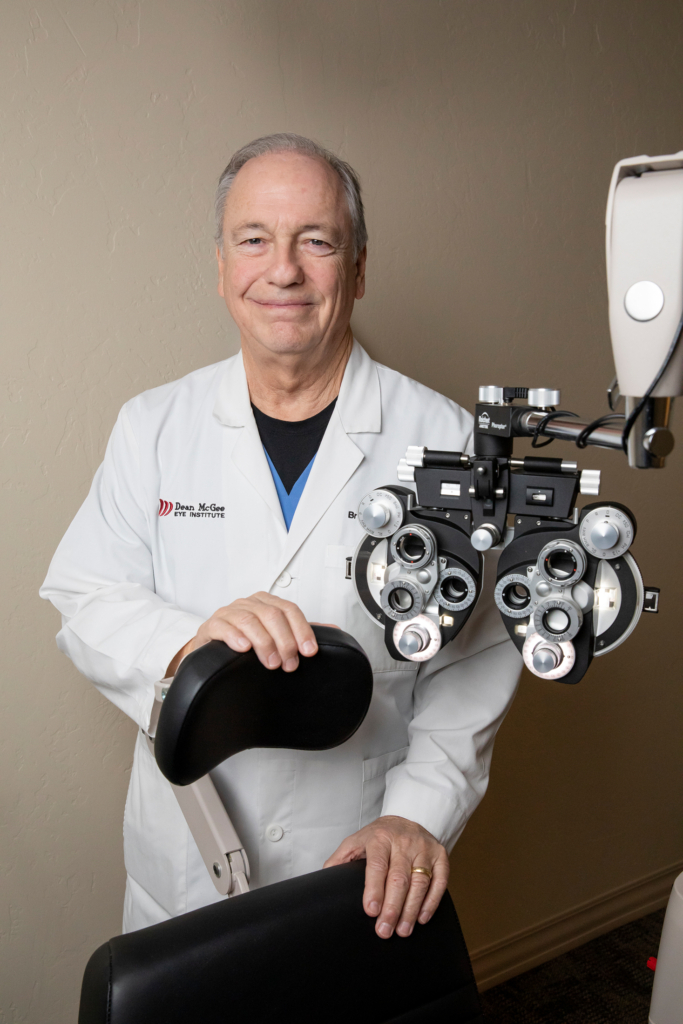Growth in the number of patients and services called for a new space for Citizen Potawatomi Nation Health Services’ Optometry Clinic. In September 2022, the department staff moved into offices behind the CPNHS West Clinic off I-40.
Comparing its previous offices in the East Clinic, neuro-ophthalmologist Dr. Bradley Farris calls the difference “night and day.”
“I think just when you walk in here, it is full of hope and joy and encouragement,” he said.
Dr. Farris spent most of his career working for Dean McGee Eye Institute in Oklahoma City, Oklahoma, until he retired in 2019. He began working with CPNHS in February 2022 to assess the optometry department’s needs and see patients part-time. Dr. Farris encouraged the Tribe to improve its facilities and quality of care.

“The vision I had for this clinic was that we would be a light on a hill. We would be the beacon. We can make the CPN eye clinic the best eye clinic in the (Indian Health Service) system and that everybody would look to us and say, ‘Wow, that’s what we want to do,’” he said.
The new space offers six exam rooms for appointments, two diagnostics rooms, an intake area with plenty of seating, an eyeglass shop and offices for three ophthalmic technicians — all with brand-new equipment, room to move around and plenty of light. Patients notice the changes during visits.
“They love this new eye clinic,” Dr. Farris said. “Just coming in here, they know that we’re willing to take the extra step to take care of them and prevent them from going blind. And that’s the key.”
Improvements
When the coronavirus pandemic hit in early 2020, medical establishments worldwide found alternatives to office visits. However, optometry requires in-person care. The CPNHS Optometry Clinic’s waiting list grew as they decreased their daily appointments and only saw urgent cases.
The new space and equipment increased the staff’s efficiency, and they now complete routine eye exams and help clients select glasses at a pre-pandemic level. The team decreased the waitlist, cutting it in half in just one year after reprioritizing patients based on their needs.
“When I first came here, we were referring out 30 patients a month to outside optometrists because we just couldn’t get to them, just for eye examinations,” Dr. Farris said. “Today, I can tell you; we’re referring out zero for routine eye care. We’re doing it all in-house. How cool is that?”
The optometry department also hired more staff, including Sarah Ford, an ophthalmic technician with 40 years of experience. She began in September as they moved to the state-of-the-art offices by the West Clinic.
“I think that (everyone on staff) is extremely gracious and helpful. If I need anything, they’re always there for me. The doctors are extremely helpful. I’m learning some new equipment that I haven’t used. And if I can’t get another tech to help me, (a doctor) will come and help me. … I’m very impressed,” she said.
The Tribe improved the speed at which patients receive their eyewear with a manufacturing and distribution contract with Dean McGee Eye Institute in Oklahoma City. The wait time averages one week.
National Eye Care Month
January is National Eye Care Month, and CPNHS patients’ overall health depends on high-quality eye care in a high-functioning facility. Dr. Farris feels discouraged when a patient’s eyesight suffers due to inaccessibility.
“There are so many things that we can offer in the eye clinic from reading glasses to glasses to diabetic preventative eye care that … is now available to patients in a new way, in an extremely high-quality eye care facility,” Dr. Farris said.
He always emphasizes the importance of an annual eye exam, especially for those with diabetes, hypertension and glaucoma (high eye pressure) — silent conditions that can gradually deteriorate a patient’s vision. They cause minor adaptations over a long period.
“You don’t know it’s happening until the damage suddenly happens or it’s already done,” Dr. Farris said.
Diabetes causes unnoticeable changes to the small blood vessels in the back of the eye, which can lead to vision loss. However, if caught early, it can be treated.
“What we try to tell our patients with diabetes, who may not have been seen by an eye doctor for two or three or four years, is that you absolutely must have a yearly dilated eye examination so that we can dilate the pupils, look in the back of the eye, and look for these early changes and treat them early before they become progressive,” Dr. Farris said.
Hypertension, or high blood pressure, causes the small blood vessels to narrow, which leads to vision loss. Dr. Farris has seen many patients throughout his career with diabetes or hypertension who do not regularly check their blood sugar levels or blood pressure and cannot offer any personal history of their conditions.
“You must take control of your own health and have someone teach you how to get it checked and know about yourself. ‘Oh, my blood sugar runs so-and-so.’ ‘Oh, I know where my blood pressure is. It’s actually been running a little low.’ These things are important information that your doctor needs to know, and it affects vision,” he said.
Dr. Farris encourages patients to make appointments to avoid complications or improve their vision. He and the staff welcome everyone to the new facility with a smile and dedication to providing the best care.
“Almost every patient will comment on, ‘Oh, this is so great. You must love your new space. Everything looks so wonderful.’ So, they’re really happy to be here. I feel like all of the responses are really positive,” Ford said.
Find more information on Citizen Potawatomi Nation Health Services at cpn.news/health. Reach the optometric services by phone at 405-214-5117.
